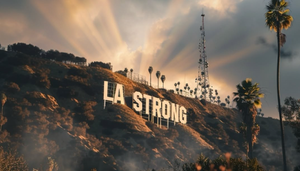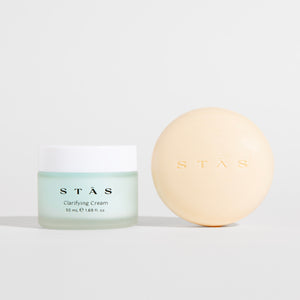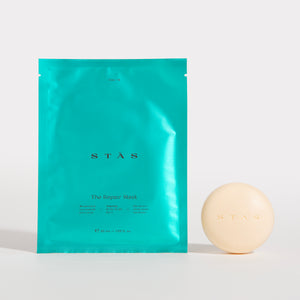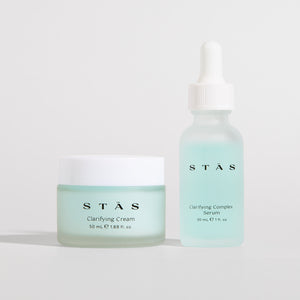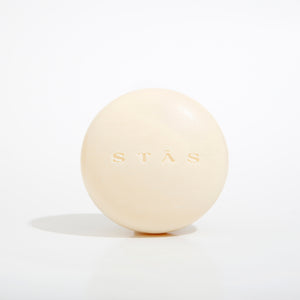Los Angeles Fires: A Skincare Guide to Protecting Your Skin from Urban Smoke and Toxins
Jan 14, 2025
Noticed your skin feeling unusually dry or irritated lately? Maybe a scratchy throat, or your usual skincare routine just isn't cutting it? If you're in LA right now, it's not just regular winter dryness – we're dealing with something specific to our city's current situation.
With fires affecting historic buildings across Los Angeles, our skin is facing a unique challenge. While you might think, "I've dealt with fire season before," these urban fires are different. They're burning through buildings from decades ago, releasing toxins that your regular air quality apps aren't even measuring.
What's Actually in the Air Right Now
- Asbestos from old building insulation (pre-1980s construction)
- Lead particles from vintage paint layers
- PCBs from old electrical systems
- Formaldehyde from aged building materials
- Heavy metals from treated wood
- Various toxins from vintage flooring and pipes
Here's the thing: your AQI app might be showing "moderate" or even "good" air quality, but it's not detecting these specific pollutants. That's why your skin might be acting up even when the air looks clear.
How Your Skin Tells You Something's Wrong
Even if you can't see the smoke anymore, your skin might be sending you signals:
- Unusual dryness or flakiness that your regular moisturizer isn't fixing
- Random breakouts in places you don't typically get them
- Skin feeling tight or uncomfortable throughout the day
- Increased sensitivity to products you normally use without issues
- A dull, tired appearance despite your usual skincare routine
What's Really Happening to Your Skin
- When these urban toxins hit your skin, they don't just sit on the surface. They can disrupt your skin barrier (your skin's natural protective shield), leading to inflammation and dehydration. And unlike regular wildfire smoke, these particles from old buildings can be particularly aggressive on your skin's protective layer.
Your Updated Skincare Game Plan
- Double Cleansing is Essential Right Now Think of it like this: your first cleanse removes all those invisible particles sitting on your skin, while your second cleanse actually cleans your skin. Don't skip this step – especially if you've been outside for more than a quick coffee run.
- Layer Up Your Hydration Your skin needs extra support to maintain its barrier: Start with a hydrating toner, add a protective serum, lock it all in with a richer moisturizer than you might typically use, and consider slugging at night (yes, really – it helps create a protective barrier)
- Recovery Mode: Use The Repair Mask 2-3 times this week (think of it as your skin's reset button). Take a break from harsh actives like strong acids or retinols. Focus on gentle, nurturing ingredients that support your skin barrier
Protect Yourself Indoors Too
Since these toxins are sneakier than regular smoke:
- Run air purifiers with HEPA filters
- Wipe down surfaces with a damp cloth daily
- Change your pillowcase more frequently
- Consider a humidifier to help your skin retain moisture
When to Take Extra Steps
Don't wait until you see smoke to protect yourself. Take additional precautions when:
- You're within a few miles of affected areas
- Your skin feels unusually sensitive
- You notice any respiratory discomfort
- There's visible dust or debris in the air
Ingredients Your Skin Needs Right Now
When choosing products during this time, look for these specific ingredients:
Barrier Repair Heroes:
- Ceramides: These lipids are like the cement between your skin cells, helping repair and strengthen your skin's barrier against urban pollutants
- Niacinamide: A powerhouse that reduces inflammation and helps repair barrier damage from environmental stress
- Panthenol (Vitamin B5): Deeply hydrates and supports skin healing, perfect for smoke-stressed skin
Antioxidant Protection:
- Vitamin C: Fights free radical damage from urban pollutants and helps brighten smoke-dulled skin
- Vitamin E: Works synergistically with Vitamin C and helps maintain your skin's protective barrier
- Green Tea Extract: Calms irritation and provides powerful antioxidant protection
Soothing Ingredients:
- Centella Asiatica (Cica): Calms irritation and supports skin healing
- Beta-Glucan: Deeply hydrating and helps reduce sensitivity
- Allantoin: Gentle skin-soother that helps with barrier repair
Hydration Heroes:
- Hyaluronic Acid: Draws moisture into the skin (extra important when air quality is compromising your skin's hydration)
- Glycerin: A humectant that helps maintain hydration levels
- Squalane: Mimics your skin's natural oils and helps prevent moisture loss
Skip These For Now:
- Harsh physical exfoliants (they can further irritate sensitive skin)
- High concentration AHAs/BHAs (your skin needs gentle care right now)
- Fragranced products (they might irritate already-sensitive skin)
Product Layering Strategy
Morning Routine:
- Gentle cleanser with barrier-supporting ingredients
- Hydrating toner or essence
- Antioxidant serum (this is your pollution shield)
- Moisturizer with barrier-repair ingredients
- SPF (more important than ever - pollution can make your skin more sun-sensitive)
Evening Routine:
- Oil-based first cleanse (to remove pollutant particles)
- Gentle second cleanse
- Hydrating layers
- The Repair Mask (2-3x weekly)
- Rich moisturizer
- Optional: Apply a thin layer of healing ointment if your skin feels particularly stressed
Long-Term Skin Protection Strategies
Indoor Protection is Key:
- Use a HEPA air purifier in your bedroom and main living spaces
- Keep windows closed during high-risk periods
- Change your pillowcase every few days
- Regular surface cleaning to remove settled particles
Listen to Your Skin:
- If your skin feels irritated, simplify your routine
- Don't introduce new active ingredients right now
- Give your skin extra time to recover between treatments
- Stay hydrated from the inside out
When to See a Professional:
- If you experience persistent irritation
- If you develop unusual rashes or reactions
- If your skin doesn't improve with gentle care
- If you have respiratory symptoms along with skin issues
Looking Ahead
While the Los Angeles fires present unique challenges for our skin, understanding what we're dealing with helps us protect ourselves more effectively. Keep an eye on local updates, listen to your skin's needs, and remember that sometimes less is more when it comes to skincare during environmental stress.
Stay tuned for our next post on winter skincare resolutions, where we'll build on these protection strategies for the season ahead.
Questions? Drop them in the comments below or DM us on Instagram. We're here to help you navigate this challenging time for our city and your skin.


